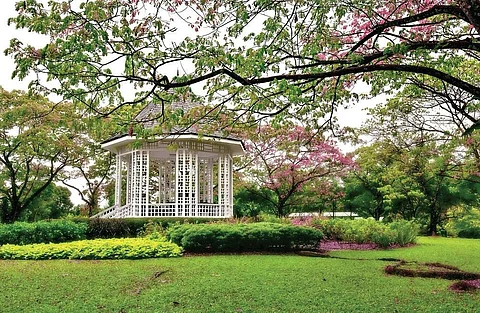

Before you step into the 157-year-old Royal Botanic Gardens in Singapore, brush up on your colour palette. Its breathtaking bursts of colours—burnished orange-yellow of the Saraca tree, flaming red of the pagoda flower, lavender blue of the morning glory, pastel pink of the Lisianthus, phosphorescent green of the Tembusu—will leave you fumbling for words in this 183-acre tropical paradise.
Neon screens with jazzy displays, imagination-defying flora, fun rides and toy trains whizzing through these gorgeous greens add up to a carnival-esque atmosphere. Vibrant butterflies flutter around the rainbow-hued premises, barely a stone’s throw from the heat and hubbub of Singapore.
The Gardens were named Singapore’s first UNESCO World Heritage Site in 2015, the world's only tropical garden to be bestowed this honour. Two other such gardens have received this title: the Royal Botanic Gardens in Kew, England, and the Padua Gardens in Italy.

Visited by 4.4 million people each year (Singapore’s population numbers 5.5 million), the Botanical Gardens may be the island-city’s crowning glory. “The Gardens’ provenance can be traced to the British colonial era in 1859, when Singapore was part of the Straits Settlements, a British colonial region administered by the East India Company,” explained our guide.
We nip up to Burkill Hall, a rare surviving example of an Anglo-Malay plantation house and one of the Gardens’ many historical structures. The entire expanse of the Gardens—the Orchid Garden, Palm Valley and the Rain Forest sections—opens up before us like a breathtaking panorama.
The Gardens housed Singapore’s first zoo. Between 1875 and 1905, it hosted kangaroos, orangutans and rhinos. So enamoured were the Japanese by these animals during their occupation of Singapore during World War II that they deputed a posse of PoWs to care for them.
The Gardens have played a catalytic role in transforming the region’s economy by pioneering agricultural techniques and processes that refined turning rubber sap into latex. Nearly 70 per cent of the world’s rubber trees can trace their roots to the Gardens. Sophisticated rubber cultivation methods triggered an economic boom in the rubber industry across Asia in early 20th century.
A hub for commercial orchid growing, hybridisation in the National Orchid Garden section has produced the world’s largest collection of the flower. There are over 60,000 types of orchids here, many of which are on the verge of extinction in their natural habitats. Gargantuan glasshouses are named after celebrities and heads of state: Elton John, Jackie Chan, Princess Diana, Nelson Mandela, Ricky Martin, Chinese President Xi Jinping, Amitabh Bachchan and Shah Rukh Khan.
“The Gardens are also home to 47 heritage trees,” the guide explained as we stood under a sprawling 200-year-old Tembusu tree whose image graces the Singapore $5 note. Symphony performances are held on a floating platform in a lily pond named Symphony Lake. Chic eateries and quick-service restaurants resonate with the happy chatter of punters. We stop by at a cafe to sample a gooey, cinnamon-dusted apple pie and a froth-topped cappuccino, and sit back to soak in the heady fragrance of flowers.